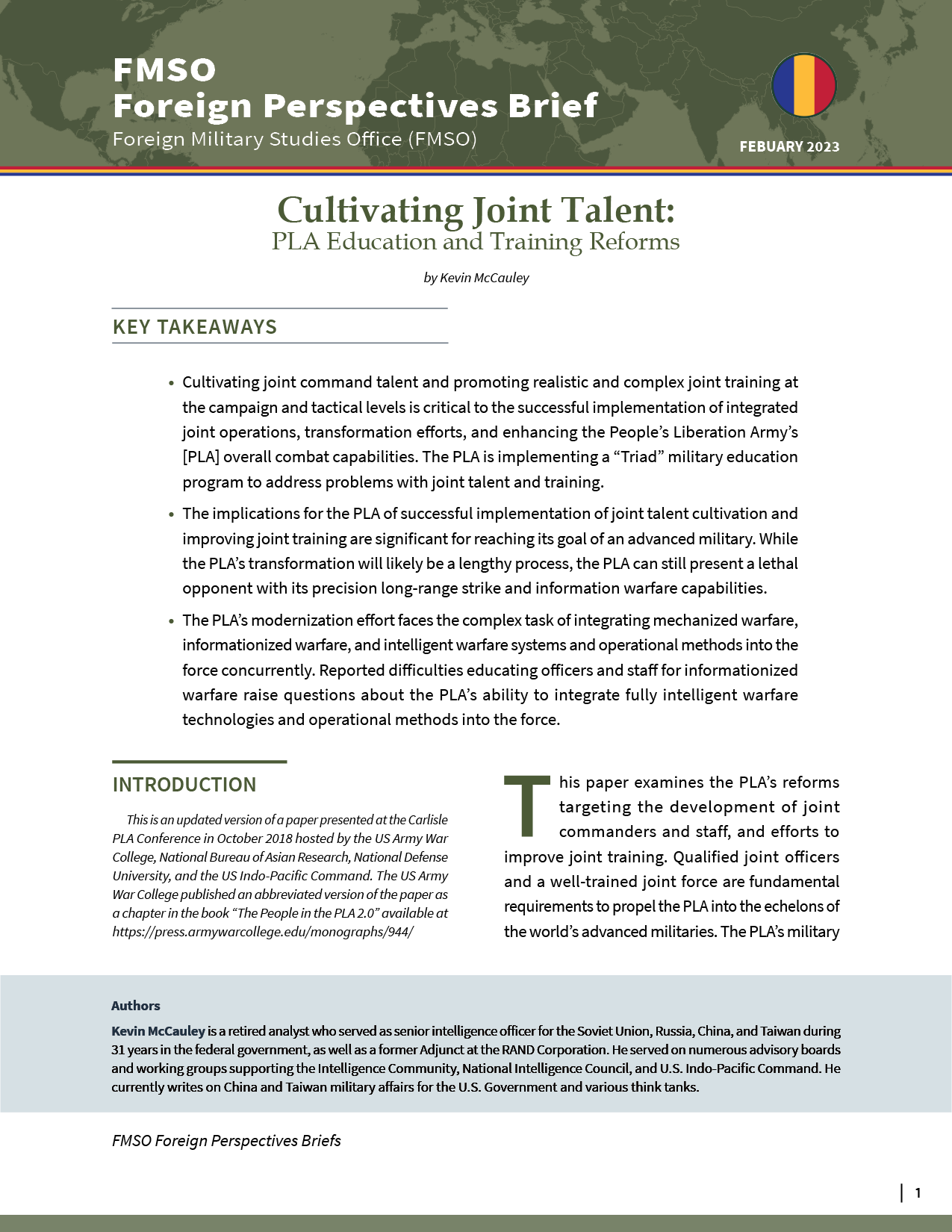
Intelligent Warfare: Human-Machine Interface
“Compared with traditional informationized operational system of systems, intelligent operational system of systems exhibit new characteristics such as autonomy, multi-dimensional, resilience, and other features to counter vulnerabilities greatly improving their robustness.”
The People’s Liberation Army (PLA) considers an evolution from the current focus on “informationized” warfare concepts, such as the theory of system of systems operational capability, to intelligent warfare concepts, according to an article in the PLA Daily. PLA researchers have developed a system of systems operational capability theory that advocates an integrated C4ISR foundation for their move towards a joint operations capability.[i] The individual systems are basic warfighting functions—command, joint fires, logistics—integrated into a larger complex system. System of systems operations using advanced information technologies integrate weapons, equipment, and units to create a synergistic effect described by the PLA as 1 + 1 > 2. This capability enables the creation of modular, recombinant task forces at the strategic, campaign or operational, and tactical levels which the PLA calls “operational system of systems.” This theoretical development has brought about the concept of warfare that the PLA describes as “system of systems confrontation,” where the main characteristic of warfare is the confrontation and destruction of competing operational systems of systems. The author also proposes the development of intelligent operational system of systems.
The evolution of the PLA’s informationized warfare to concepts to one based on emerging intelligent technologies is described in the attached article in the PLA Daily. The author makes a transition to an intelligent operational system of systems to describe a task-organized force and warfare based on intelligent confrontation. This updates the current PLA view of system of systems confrontation based on information-based systems to a warfare system based on intelligent technologies. The author views the intelligent operational system of systems as a task force similar to the information-based operational system of systems composed of the required force modules—for example, command, maneuver, joint fires, and reconnaissance—but more resilient, autonomous, robust, and multidimensional.
However, the author highlights vulnerabilities that could be exploited. The intelligent operational system of systems will be heavily reliant on data to support an intelligent decision-making model. The author believes such a model has weak adaptability based on algorithm construction and parametric establishment. The intelligent decision-making model is only as good as its construction by humans, and unforeseen situations could cause errors leading to disaster on the battlefield. System security could also cause risks. Control of the intelligent operational system of systems will be difficult as its modular forces are dispersed across the physical domain, connected by the information domain, and compete in the cognitive domain. Data distortion and information damage can occur during combat as data, signals, commands, and information are transmitted across domains undergoing multiple interactions with humans and machines. Multiple and complex interactions in the command system across multiple domains can result in corruption of information. The author notes that the intelligent operational system of systems will be more autonomous, but many critical actions will still require humans to be in the loop. The contention that, as important as technology is, humans are decisive for victory in wars is a common theme in PLA articles on artificial intelligence. This belief questions the degree of human control the PLA is willing to cede to autonomous systems.
Sources:
“脆弱性:智能化作战体系“阿喀琉斯之踵 (Vu“nerability: t”e “Achilles Heel” of the Intelligent Operational System of Systems),” PLA Daily (Official PRC Military Newspaper), 6 May 2023. http://www.81.cn/szb_223187/szbxq/index.html?paperName=jfjb&paperDate=2023-05-16&paperNumber=07&articleid=905942
“The inexplicable nature of algorithms can lead to risks. As a special adversarial activity, the decision-making process of military intelligent sys“ems should have ”interpretability”, which means that people can understand the logical process and results of intelligent algorithm decision-making. However, the current artificial intelligence system algo“ithms exh”bit a “black box” feature, making it difficult for humans to understand and master its decision-making process. Minor changes and adjustments to simple parameters such as initial conditions and weights may result in complex results. This means that intelligent systems have structural vulnerabilities, unpredictable decision-making risks, and are highly likely to produce erroneous or even dangerous decisions. At the same time, this also leads to hidden backdoors or vulnerabilities in the data, algorithms, models, etc. of military intelligence systems, making it impossible to predict system security risk.It is difficult to completely trust the human-machine system. In the intelligent operational system of systems, command agencies at all levels collaborate with humans and machines, and the human brain and machine brain jointly constitute the command subject. During the combat process, in addition to human brain commands, all levels also need to implement the instructions issued by the computer brain. Due to the limitations of artificial intelligence“technolog”, the “black box” decision-making process, and human subjective consciousness, it is difficult for humans to unconditionally trust and accept machine decision results. This sense of distrust can be reduced through long-term human-machine collaborative training, but it cannot be absolutely eliminated. At a critical moment in the development of the battlefield situation, if there is a disagreement between the decision-making results of humans and machines, it will inevitably affect the speed and quality of decision-making.”
Notes:
[i] See Kevin McCauley, “PLA System of Systems Operations: Enabling Joint Operations,” Jamestown Foundation, 30 January 2017. https://jamestown.org/product/pla-system-systems-operations-enabling-joint-operations-kevin-mccauley/
Image Information:
Image: Intelligent Warfare: Human-Machine Interface
Source: https://commons.wikimedia.org/wiki/File:Internet_of_Battlefield_Things.tif
Attribution: CCDC Army Research Laboratory (Public Domain)

